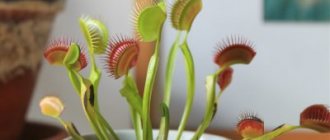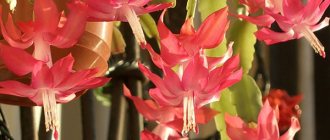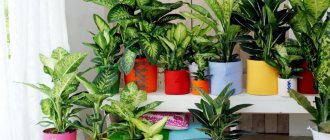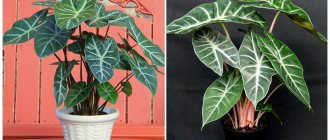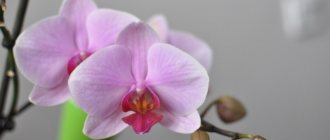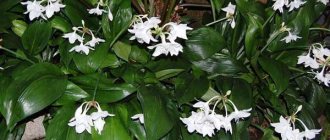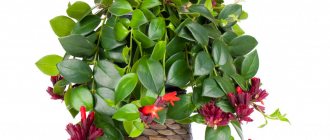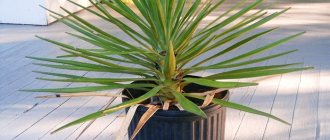Dieffenbachia is a plant native to the tropical zone of America. Belongs to the Aroid family (Araceae). Many species are characterized by large and variegated, elongated oval in shape, highly decorative leaves.
Dieffenbachia is a plant native to tropical America.
- Temperature, humidity, lighting
Signs and superstitions associated with Dieffenbachia
The decorative perennial is incredibly popular among amateur gardeners, but not everyone knows where the negative signs associated with such a plant come from, and why many people still associate such a flower with troubles and misfortunes. In ancient times, such a flower was widely used as a torture device for slaves . It's all about the presence of plant juice with toxic components.
The offender was forced to slowly chew the leaves of such a plant. Of course, a small amount of toxins did not cause the death of a slave, but caused severe swelling that did not allow the person to speak. Thus, the risk of causing death or serious physical injury was minimal, but the offenders were very afraid of such punishment.
Description of species and varieties of Dieffenbachia
Absolutely all varieties of this genus are characterized by thick and succulent stems, on which green leaves with white spots are located. The growth point of a perennial is most often located in the apical part of the shoot, but bushy forms sometimes have dormant buds at the base of the stems. The maximum height, as a rule, does not exceed a couple of meters, but during the growth process, the trunk part gradually becomes exposed, which causes a decrease in decorativeness. Flowering is rare in indoor floriculture. Flowers are collected in inflorescences or cobs.
Dieffenbachia spotted Camilla, Tropic snow, Tropic san
D. maculata - has very wide leaf blades, on which white spots are concentrated along the lateral veins. This species was used in the breeding of the cultivars “Camilla”, “Tropic Snow” and “Tropic Sun”. For example, the popular Tropic Snow variety is characterized by a predominance of white foliage.
Dieffenbachia Tropic snow
Dieffenbachia compacta
D. Compasta is a variety characterized by very small, compact sizes, with a height of the above-ground part of no more than 35-40 cm. The foliage is spotted, medium in size, located on dense shoots.
Dieffenbachia lovely (pleasant)
D.amoena is an unpretentious variety that is quite easy to care for. The above-ground part is no more than one and a half meters high with half-meter dark green leaves and white stripes along the veins.
Dieffenbachia macrophylla
D.macrophylla is a variety with a strong stem no more than a meter high and dark green, oblong-ovate or broadly ovate leathery leaves with a fairly thick central vein.
Also read: Secrets of caring for chlorophytum at home and description of plant species
Dieffenbachia macrophylla
Dieffenbachia baraguina
D.baraquiniana is a variety characterized by the presence of snow-white petioles and dark green foliage, with rare white spots of irregular shape and a white mid-vein.
Dieffenbachia Leopolda
D. leoroldii - the species is characterized by a short stem, no more than 50-60 mm in height and up to 20 mm in diameter, with green petioles with purple spots. The leaf blades are wide elliptical in shape, dark green, with a white central vein.
Dieffenbachia Leopolda
Dieffenbachia seguina
D.seguine is a variety characterized by the formation of fairly wide and large leaf blades, on the surface of which there is a small number of white spots. The number of lateral veins does not exceed twelve.
Dieffenbachia Oersted
D.oerstedii - this species has oval-pointed or elongated heart-shaped leaves no more than 35-37 cm long. The foliage is green in color, with a pronounced central vein of light green color.
Dieffenbachia Oersted
Dieffenbachia baumann
D.bowmannii is a very popular variety with the largest leaves, the length of which, as a rule, exceeds half a meter. The leaf blade has a pronounced green color and is covered with very characteristic, small and light dots.
Dieffenbachia bush Green Magic
D.Green Magic is one of the most popular and well-known hybrid forms, forming a dense and low bush with dark bluish-green leaves and a white central vein.
Reasons for appearance on indoor plants with photos
Unfortunately, this phenomenon is not uncommon, and it can occur for various reasons. This is usually due to parasites, pests, diseases or improper living conditions.
On the leaves of flowers
Most often, powdery mildew is the culprit of white plaque on leaves. It is caused by microscopic mycelial fungi, which are brought into the house by people (on clothes, shoes), and pets (on fur). Also, mycelia can get onto plants along with soil or already infected ornamental crops purchased in a store.
The mycelium spreads quickly, parasitizing the plant and feeding on its juices. First, characteristic white spots form - traces of spore invasion. Then they grow, and the plant becomes covered with small whitish spots - hence the name of the disease.
Then the white spots turn rusty, the leaves dry out and fall off along with the buds.
The following crops are most vulnerable in this regard:
- Kalanchoe;
- chrysanthemum;
- begonia;
- ficus
If the growth of the mycelium is not stopped in time and is not destroyed, the plant will inevitably die in a fairly short period of time.
IMPORTANT! Powdery mildew actively develops in rooms with high humidity. Another attractive environment for fungi is drops of water that fall on the leaves during spraying. Make sure they don't stay there for long.
Another typical cause of plaque can be the appearance of mealybugs. This is a parasitic insect similar to an aphid. Its appearance is easy to notice: it’s as if someone sprinkled flour on the plant, after which its leaves become sticky.
It is curious that some indoor crops do not suffer from it at all, but the monk loves some especially, for example, Kalanchoe.
The appearance of a pest on different crops may look different:
- Dracaena leaves immediately become sticky. Later they begin to fall off;
- the orchid's buds and young shoots become deformed;
- on the money tree, the scale insect is visible in the form of lumps in the axils of the leaves;
- in violets it initially affects the root system.
The parasite has a vulnerable spot - it is afraid of moisture. Where regular watering is carried out, dry leaves and buds are removed, and regular spraying is done, this parasite does not appear.
The cause of the white coating can also be white aphids. On a healthy leaf it is not noticeable for long, since the affected part of the crop quickly withers, dries and falls off.
The parasitism of aphids is manifested in the fact that they suck out the juices of the plant, and thus deprive it of its ability to live. If countermeasures are not taken, your green pet will die from exhaustion.
Why is the soil in pots covered?
Often the soil in pots is covered with a white coating. This is either a special type of fungal mold, characteristic of indoor conditions, or efflorescence - salt deposits. Both are destructive for plants, especially young ones. Mold and excess salts can lead to the death of the entire root system.
There are several reasons for this phenomenon:
- Any mold is formed due to excess moisture. Frequent watering is the most common cause of the formation of white plaque;
- dry indoor air will not cause mold, but it will lead to soil salinization. As a result, salt comes to the surface;
- if the pot for the plant is too large, its roots do not reach the lower layers of soil and do not absorb moisture from there. The accumulated water becomes a breeding ground for fungi and mold;
- improper selection of fertilizers or their excessive use can also cause salt deposits;
- Despite the fact that the presence of drainage in a pot is mandatory, not everyone uses it, so moisture stagnates in the ground and mold is activated.
Sometimes white spots indicate contamination of the soil by the larvae of fungus gnats - sciarids. If there are a lot of them, it is advisable not to use the soil at all, but to cultivate and replant the plant.
IMPORTANT! It happens that white spots on the soil indicate that the plant is watered with hard water with an excess of mineral salts. Such water is harmful not only to humans (it forms kidney stones), but also to plants.
Therefore, it will be better for both your pets and yourself if you purchase water softeners. Now they are sold almost everywhere and are inexpensive.
Caring for Dieffenbachia at home
Almost all varieties of such decorative tropical perennials are completely unpretentious and fast-growing plants that absolutely do not require complex special care.
However, in order to maintain its decorative appeal for many years, it is very important to strictly follow the regime of irrigation and fertilization. Among other things, it is imperative to provide the plant with the most comfortable microclimatic conditions for full growth and development.
Temperature, humidity, lighting
Dieffenbachia of any variety is light-loving, and also prefers the presence of fairly intense lighting in the room, but without direct rays of the sun hitting the above-ground part. That is why, on especially hot summer days, it is advisable to place a flower pot with a crop in the partial shade of an eastern or western window.
If an ornamental plant is supposed to be grown on a south-facing window, then it is best to install the flower pot at a distance of a meter from the window. In winter, on the contrary, the crop should be placed in the brightest place. Strong shading causes problems : the leaves turn yellow, and the plant itself often withers, and excessive lighting causes discoloration of the foliage.
It is imperative to provide Diffembachia with the most comfortable microclimatic conditions for full growth and development.
In winter and late autumn, the temperature in the room should be approximately 16-18°C. It’s not scary if the temperature drops briefly to 13-14°C. also very important to remember that drafts are strictly contraindicated for culture. The perennial is very responsive to high levels of indoor air humidity. Starting from spring and until the first ten days of autumn, it is imperative to provide all varieties with regular daily spraying of foliage.
Also read: Soy: chemical composition and nutritional value of medicinal beans
Starting from mid-autumn and throughout the winter period, spraying can be done only a couple of times a week. A completely worthy replacement for spraying would be to place the flower pot on a tray with wet expanded clay. It is equally important to remove dust from the above-ground part with well-settled tap water at room temperature or using special cosmetics that allow you to remove whitish spots from leaf plates.
Dieffenbachia of any variety is light-loving
Soil and flower pot
The tropical perennial grows very well in soil mixtures with an acidity of 5.6-5.8 pH. The soil must be breathable and breathable . This type of soil allows oxygen to freely penetrate to the root system, and water does not stagnate at the roots.
Perfect for growing any universal substrate suitable for cultivating decorative foliage plants with the addition of a small amount of peat chips and charcoal. To independently make the correct nutrient substrate, you need to mix four parts of leaf soil, two parts of peat chips, a couple of parts of sphagnum moss, one part of medium-fraction sifted sand and half of a part of charcoal.
To ensure a comfortable position for the root system, you need to choose a medium-sized flower pot, slightly larger than the volume of the roots. A prerequisite when choosing a high-quality planting container is the presence of a sufficient number of drainage holes in the bottom. Among other things, the flowerpot must be made of heavy materials, which will ensure its stability.
Dieffenbachia grows very well in soil mixtures with an acidity of 5.6-5.8 pH
How to water a flower correctly
Irrigation activities should be moderately abundant from the beginning of spring until the onset of autumn, which is due to the large leaf mass and increased water evaporation. During the process of evaporation, the foliage may sometimes appear to be crying. However, an excess amount of water can cause root rot, so watering is done with well-settled water at room temperature only after the soil substrate in the flower pot has dried out by about a third. In autumn and winter, you must also follow the watering regime, and do it only when the soil has dried sufficiently.
How often and under what conditions does Dieffenbachia bloom?
The inflorescences are ears that vaguely resemble corn. Flowering usually occurs in spring and begins in April or May . The inflorescence appears from the leaf axil and has a cream or greenish cover.
In indoor floriculture, flowering is rare and does not last long, after which the inflorescence fades and needs to be cut off. If this is not done, red or reddish-orange poisonous berries will form. The formation of seed material greatly depletes the plant.
In indoor floriculture, Dieffenbachia flowering is rare and does not last long.
Repotting a houseplant
After the root system has completely filled the entire volume of the flower pot, the plant needs to be replanted. Experienced amateur flower growers recommend replanting the crop in early spring, after breaking dormancy. During the transplantation process, the woven roots are carefully untwisted, after which they are carefully examined. All identified areas of damage and lesions are cut off and sprinkled with powdered charcoal.
Also read: Achimenes in indoor breeding: description of species and secrets of care at home
How and when to fertilize Dieffenbachia
It is especially important to properly feed the crop at the stage of active growth, which occurs in the spring-summer period. Varieties with green leaves are fed with fertilizers that do not contain lime. It is recommended to feed variegated varieties with standard mineral fertilizers approximately once every three weeks.
It is especially important to properly feed Dieffenbachia at the stage of active growth, which occurs in the spring-summer period.
Mold Removal
The fight against mold consists of removing the affected parts of indoor flowers and preventive antifungal treatments. It is also important to restore the microclimate and create suitable conditions for plants.
When treating white plaque, you need to carry out comprehensive measures and regularly inspect healthy flowers so as not to miss the moment and start treatment in a timely manner. But treating diseases is much more difficult than preventing their development. Therefore, systemic preventive measures should be carried out.
This is interesting: Planting garlic. When is the best time to plant
Aktara
Strong insecticide with mixed effects. Used for surface application and watering. Price from 12 rub. for 1 g of dry powder. It is considered one of the most effective, since it has an intestinal contact effect on adult insects, their larvae and clutches.
Apply externally to flowers from a spray bottle. Dissolves at the rate of 1 g per 1.2 liters of water. Then the pot should be covered with a bag and left for about an hour.
The product is not washed off. Its effect begins within 24 hours when applied externally and after 2-4 days when watered. To apply to the soil, 1 g of the product is dissolved in 10 liters of water.
The mixed procedure is performed repeatedly (from 2 to 5 times with a difference of 10-14 days), focusing on the air temperature.
Green soap
Brown or greenish liquid with a soapy odor. The main component is potassium salts, which have a detrimental effect on pests, destroying the habitat and blocking the access of oxygen to scale insects, their eggs and larvae, without which the parasites die.
Dilute 250 ml in 10 liters of water, mix thoroughly, and evenly spray the green part of the plant. Treatment should be performed 3-4 times with an interval of 3 weeks. Price from 29 rub. for 250 ml. According to reviews on the forums, it is a very effective tool and receives positive ratings.
Fitoverm
Fitoverm is a biological preparation that is safe for people and animals. Many experienced gardeners advise starting to process plants with it. Price from 9 rub. for 2 ml.
A safe solution is made from 2 ml of product and 200 ml of water. Treat by spraying or wiping. Designed for contact action. In recent years, scale insects have become accustomed to the drug.
When the plant is seriously affected, more toxic substances are chosen (Vermitek, Karbofos, Actellik), spraying them on the street.
Important: chemical treatment must be carried out wearing personal protective equipment, avoiding contact of the solution on the skin and mucous membranes (eyes, mouth, respiratory organs) as much as possible. After contact with the drugs, wash exposed areas of the body with running water and soap.
Methods for propagating Dieffenbachia
Seeds, as a rule, do not ripen, so the ornamental crop is most often propagated vegetatively. For this purpose, you can use apical cuttings, stem cuttings, as well as lateral shoots. Cuttings and rooting should be carried out in the spring, with the beginning of the active growing season. The cuttings are placed in a special nutrient medium, represented by water or soil, where the rooting process takes place.
The first option is more convenient and easier. It is very important to add a couple of tablets of activated carbon to the water for rooting. Until roots appear on the cuttings, the temperature should be maintained at 21-24°C. Then the young plants are planted in a nutritious soil mixture.
Dieffenbachia transplant
Transplantation is performed every year, usually in spring or early summer. Young plants are transplanted into larger pots - 1-2 cm larger in diameter than the previous ones. Tall, large Dieffenbachias, the further growth of which is undesirable, are left in old pots. Since replanting such plants can be difficult due to their size, it is advisable to replace only the top layer of soil with good nutritious soil, for example, with the addition of compost.
The pot for Dieffenbachia is selected according to the size of the root system
Plant diseases and pests
The main diseases and pests that can affect all varieties of Dieffenbachia are:
- leaf spotting , accompanied by the appearance on the leaf blades of small round brown spots with an orange border. When the first signs appear, treatment is carried out with systemic fungicides;
- fusarium , in which elongated dark spots form on the root collar and roots, and the above-ground part turns yellow and withers. Trichodermin is used for prevention, and treatment is performed with Rovral or Fundazol;
- anthracnose , which causes the appearance of fairly large spots on the edges of the leaf blade, followed by drying out of the plant. When the first signs appear, treatment is carried out with Vitaros or Fundazol;
- root rot , which causes fairly rapid withering of the above-ground part of the decorative perennial. Treatment is carried out with systemic fungicides, including Profit-Gold, Ridomil-Gold and Previkur;
- bacteriosis , accompanied by the appearance of watery spots on the plant. The plant cannot be treated.
Of the plant parasites, the crop is most often affected by spider mites, scale insects, aphids, thrips and mealybugs, which are destroyed by mechanical removal with a soap solution, followed by treatment with a solution based on the preparations “Actellika” or “Karbofos”, diluted at the rate of fifteen drops per liter water.
Difficulties in growing a flower
Problems during cultivation most often manifest themselves as constantly moist soil, falling leaves, wilting of the above-ground parts, and the appearance of a whitish coating on the soil surface. To avoid such unpleasant phenomena, it is very important to follow the watering and fertilizing regime, as well as provide the crop with the correct temperature and humidity levels in the room.
Currently, the peak popularity of such an ornamental foliage plant as indoor Dieffenbachia has decreased slightly, which is due to its significant size and the need to frequently renew a fast-growing crop.
Treatment and prevention.
A fungal disease can cause a moldy coating on the plant or soil. If the infection is not severe, it is enough to disinfect the soil. For this, a weak solution of magranz or a special product can help you. Sometimes, if the moldy deposit is only on the surface of the soil, the top layer of soil can be replaced with a new one. In case of severe infection and if disinfection does not help, you will have to completely replace the soil in the pot.
When replacing the soil, you will need to carefully free the plant, try to minimally injure the root system. The plant must be dried for 24 hours, then planted in a new pot and the soil completely replaced. If mold appears on the stem or leaves, try wiping the plant with a damp cloth. If the mold is removed, then the damage is not big. But if mold spots remain, then the infection has already penetrated deep into the plant, you will have to remove all the affected leaves and shoots. Next, we disinfect the soil.
Infection with mealybugs is a rather labor-intensive task. In case of early infection, it is enough to collect the pest with a cotton swab dipped in an alcohol solution. Then the entire plant should be treated with a special preparation. From personal experience I can say that treating the plant with a weak feri solution helps a lot.
After treating the plant (spraying or wiping the leaves), it is better to put it in a plastic bag. When using a detergent or soap solution, the procedure of washing leaves and shoots must be carried out until the pest completely disappears. Of course, the use of appropriate medications will speed up the treatment process.
Gray rot, which also has a white coating, is practically incurable; if the plant is severely damaged, it dies. Most likely the cause of this disease is poor care.
Powdery mildew - here you need to understand what kind of powdery mildew it is. Since it could also be downy mildew. In the early stages of infection, a manganese solution copes well with the problem. Which should be sprayed on plants. In case of severe infection, we use appropriate medications.
As a preventive measure and to avoid infection with white plaque, a number of measures should be followed that will allow you to avoid infection and the appearance of pests and diseases.
- — we update the soil in the pot; if the root system is well developed, then it is enough to update the top layer of soil.
- - of course, control over watering, it should not be too frequent, and also not allow the earthen clod to dry out. You should also take care of good drainage.
- — every season, when plants are more active in growth and development (spring-summer), we carry out preventive spraying with appropriate preparations.
pest control products
To prevent your indoor plants from becoming infected or affected by pests and diseases. Try to follow all the rules for growing indoor plants. We pay special attention to the soil or soil. If you create the soil mixture yourself, it should be disinfected. It is advisable to treat all soil mixtures with appropriate preparations; if this mixture includes sand, it can be calcined in the oven. The ready-made soil mixture sold in stores is not always good. It may even contain pest larvae or fungal spores. It is advisable to treat it also for prevention.
When planting, use drainage, as well as vermiculite or perlite, which we add to the soil, it loosens the soil. Good drainage will allow excess moisture to escape into the pan. Stagnant moisture and constantly damp soil are good conditions for the development of fungal diseases and all kinds of rot. We pay attention to watering. It must be timely and take into account the requirements of the plant. Excessive watering or drying out the earthen coma contributes to a decrease in its own protective qualities and the formation of problems. Good luck to you.

